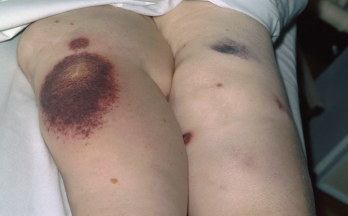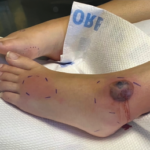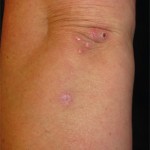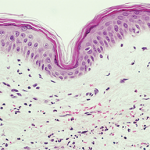
Clinical Photography, Central Manchester University Hospitals NHS Foundation Trust, UK/Science Source / shutterstock.com
CHICAGO—Physicians from the University of Chicago presented an intriguing case of Sweet’s syndrome for the Clinical Pathological Conference during the 2018 ACR/ARHP Annual Meeting.
Pankti Reid, MD, MPH, a rheumatology fellow at the University of Chicago, introduced the case of a white man who, in 2017, came under the care of the University of Chicago. She explained that in 2015, the then 56-year-old man presented at a different institution, where he was diagnosed with anti-neutrophil cytoplasmic antibody-associated vasculitis. The diagnosis was based on a presentation of uveitis, fever, cough, weight loss, cytopenia, a high erythrocyte sedimentation rate and high C-reactive protein. That institution prescribed rituximab and prednisone.
In 2017, when the patient arrived at the University of Chicago, his symptoms included fever, night sweats, weight loss and fatigue. “Overall, he was just an ill-looking gentleman,” said Dr. Reid. Even though he was receiving rituximab, he was unable to reduce prednisone to below 20 mg daily without recurrence of arthralgias and fatigue. He had been suffering from fever for approximately three weeks and had a nonproductive cough. His oxygen level was 95% on room air, and he was diaphoretic. Laboratory tests revealed 90% neutrophilia and low hemoglobin at 6.7 g/dL. A thorough infectious agent workup was conducted, with unremarkable results.
He was admitted to the hospital where he experienced recurring fevers, despite 72 hours of treatment with antibiotics. While hospitalized, he also had signs of volume overload and was treated with aggressive diuresis.
Pulmonary Imaging
Jonathan H. Chung, MD, section chief of thoracic radiology and associate professor of radiology at the University of Chicago, continued the presentation with a discussion of the patient’s pulmonary imaging. “A lot of time, as a radiologist, I can’t give you a specific diagnosis,” said Dr. Chung, who explained that when he sees something on an image, it could be water, blood, pus, cells or inflammation. In this case, the computed tomography (CT) scan could have meant the patient had pulmonary hemorrhage, pneumonia or aspiration leading to pneumonia.
Dr. Chung described in detail the visible abnormality in the patient’s lung, which looked like a tree-in-bud nodularity and was consistent with aspiration pneumonia. Although typically such an image is diagnostic of aspiration pneumonia, he reminded the audience the image was showing something in the bronchioles, and he noted vasculitis can also manifest as a tree-in-bud nodularity. In the case of this patient, 27 days after admission, the tree-in-bud nodularity had worsened, suggesting more fluid in the lungs.


